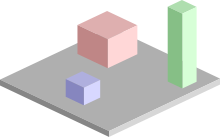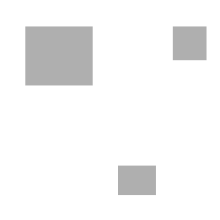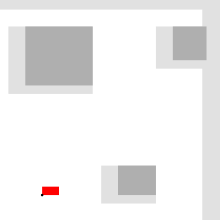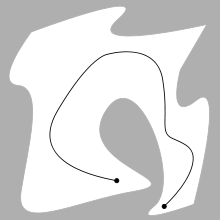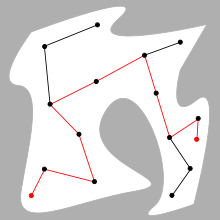A driverless car is a vehicle equipped with an autopilot system, and capable of driving from one point to another without aid from an operator. Driverless passenger car programs include the 800 million EC EUREKA Prometheus Project on autonomous vehicles, the 2getthere passenger vehicles from the Netherlands, the ARGO research project from Italy, the DARPA Grand Challenge from the USA, and Google driverless car.
History
An early representation of the driverless car was Norman Bel Geddes's Futurama exhibit sponsored by General Motors at the 1933 World's Fair, which depicted electric cars powered by circuits embedded in the roadway and controlled by radio.
The history of autonomous vehicles starts in 1977 with the Tsukuba Mechanical Engineering Lab in Japan. On a dedicated, clearly marked course it achieved speeds of up to 30 km/h (20 miles per hour), by tracking white street markers (special hardware was necessary, since commercial computers were much slower than they are today).
In the 1980s a vision-guided Mercedes-Benz robot van, designed by Ernst Dickmanns and his team at the Bundeswehr University of Munich in Munich, Germany, achieved 100 km/h on streets without traffic. Subsequently, the European Commission began funding the 800 million Euro EUREKA Prometheus Project on autonomous vehicles (1987–1995).
Also in the 1980s the DARPA-funded Autonomous Land Vehicle (ALV) in the United States achieved the first road-following demonstration that used laser radar (Environmental Research Institute of Michigan), computer vision (Carnegie Mellon University and SRI), and autonomous robotic control (Carnegie Mellon and Martin Marietta) to control a driverless vehicle up to 30 km/h. In 1987, HRL Laboratories (formerly Hughes Research Labs) demonstrated the first off-road map and sensor-based autonomous navigation on the ALV. The vehicle travelled over 600m at 3 km/h on complex terrain with steep slopes, ravines, large rocks, and vegetation.
In 1994, the twin robot vehicles VaMP and Vita-2 of Daimler-Benz and Ernst Dickmanns of UniBwM drove more than one thousand kilometers on a Paris three-lane highway in standard heavy traffic at speeds up to 130 km/h, albeit semi-autonomously with human interventions. They demonstrated autonomous driving in free lanes, convoy driving, and lane changes left and right with autonomous passing of other cars.
In 1995, Dickmanns´ re-engineered autonomous S-Class Mercedes-Benz took a 1600 km trip from Munich in Bavaria to Copenhagen in Denmark and back, using saccadic computer vision and transputers to react in real time. The robot achieved speeds exceeding 175 km/h on the German Autobahn, with a mean time between human interventions of 9 km, or 95% autonomous driving. Again it drove in traffic, executing manoeuvres to pass other cars. Despite being a research system without emphasis on long distance reliability, it drove up to 158 km without human intervention.
In 1995, the Carnegie Mellon University Navlab project achieved 98.2% autonomous driving on a 5000 km (3000-mile) "No hands across America" trip. This car, however, was semi-autonomous by nature: it used neural networks to control the steering wheel, but throttle and brakes were human-controlled.
From 1996–2001, Alberto Broggi of the University of Parma launched the ARGO Project, which worked on enabling a modified Lancia Thema to follow the normal (painted) lane marks in an unmodified highway. The culmination of the project was a journey of 2,000 km over six days on the motorways of northern Italy dubbed MilleMiglia in Automatico, with an average speed of 90 km/h. 94% of the time the car was in fully automatic mode, with the longest automatic stretch being 54 km. The vehicle had only two black-and-white low-cost video cameras on board, and used stereoscopic vision algorithms to understand its environment, as opposed to the "laser, radar - whatever you need" approach taken by other efforts in the field.
Three US Government funded military efforts known as Demo I (US Army), Demo II (DARPA), and Demo III (US Army), are currently underway. Demo III (2001)demonstrated the ability of unmanned ground vehicles to navigate miles of difficult off-road terrain, avoiding obstacles such as rocks and trees. James Albus at NIST provided the Real-Time Control System which is a hierarchical control system. Not only were individual vehicles controlled (e.g. throttle, steering, and brake), but groups of vehicles had their movements automatically coordinated in response to high level goals.
In 2002, the DARPA Grand Challenge competitions were announced. The 2004 and 2005 DARPA competitions allowed international teams to compete in fully autonomous vehicle races over rough unpaved terrain and in a non-populated suburban setting. The 2007 DARPA challenge, the DARPA urban challenge, involved autonomous cars driving in an urban setting.
In 2008, General Motors stated that they will begin testing driverless cars by 2015, and they could be on the road by 2018 .
In 2010 VisLab ran VIAC, the VisLab Intercontinental Autonomous Challenge, a 13,000 km test run of autonomous vehicles. The four driverless electric vans successfully ended the drive from Italy to China via the arriving at the Shanghai Expo on 28 October.
Recent projects
The work done so far varies significantly in its ambition and its demands in terms of modification of the infrastructure. Broadly, there are three approaches:
Fully autonomous vehicles
Various enhancements to the infrastructure (either an entire area, or specific lanes) to create a self-driving closed system.
"assistance" systems that incrementally remove requirements from the human driver (e.g. improvements to cruise control)
An important concept that cuts across several of the efforts is vehicle platoons. In order to better utilize road-space, vehicles are assembled into ad-hoc train-like "platoons", where the driver (either human or automatic) of the first vehicle makes all decisions for the entire platoon. All other vehicles simply follow the lead of the first vehicle.
]Fully autonomous
Fully autonomous driving requires a car to drive itself to a pre-set target using unmodified infrastructure. The final goal of safe door-to-door transportation in arbitrary environments is not yet reached though.
Vehicles for paved roads
Google driverless car, with a test fleet of autonomous vehicles that by October 2010 have driven 140,000 miles (230,000 km) without any incidents.
The 800 million Euro EUREKA Prometheus Project on autonomous vehicles (1987–1995). Among its culmination points were the twin robot vehicles VITA-2 and VaMP of Daimler-Benz and Ernst Dickmanns, driving long distances in heavy traffic (see #History above).
The VIAC Challenge, in which 4 vehicles drove from Italy to China on a 13,000 kilometres (8,100 mi) trip with only limited occasions intervene by human, such as in the Moscow traffic jams and when passing toll stations. This is the longest-ever trip by an unmanned vehicle.
The third competition of the DARPA Grand Challenge held in November 2007. 53 teams qualified initially, but after a series of qualifying rounds, only eleven teams entered the final race. Of these, six teams completed navigating through the non-populated urban environment, and the Carnegie Mellon University team won the $2 million prize.
The ARGO vehicle (see #History above) is the predecessor of the BRAiVE vehicle, both from the University of Parma's VisLab. Argo was developed in 1996 and demonstrated to the world in 1998; BRAiVE was developed in 2008 and firstly demonstrated in 2009 at the IEEE IV conference in Xi'an, China.
Stanford Racing Team's Junior car is an autonomous driverless car for paved roads. It is intended for civilian use.
The Volkswagen Golf GTI 53+1 is a modified Volkswagen Golf GTI capable of autonomous driving. The Golf GTI 53+1 features a implemented system that can be integrated into any car. This system is based around the MicroAutoBox from dSpace. This, as it was intended to test VW hardware without a human driver (for consistent test results).
The Audi TTS Pikes Peak is a modified Audi TTS, working entirely on GPS, and thus without additional sensors. The car was designed by Burkhard Huhnke of Volkswagen Research.
Stadtpilot, Technical University Braunschweig
AutoNOMOS - part of the Artificial Intelligence Group of the Freie Universität Berlin
Free-ranging vehicles
There are three clusters of activity relating to free-ranging off-road cars. Some of these projects are military-oriented.
US military DARPA Grand Challenge
Main article: DARPA Grand Challenge
The US Department of Defense announced on the July 30, 2002 a "Grand Challenge", for US-based teams to produce a vehicle that could autonomously navigate and reach a target in the desert of the south western USA.
In March 2004, the first competition was held, for a prize-money of $1 million. Not one of the 25 entrants completed the course. However, in the second competition held in October 2005 five different teams completed the 135-mile (217 km) course, and the Stanford University team won the $2 million prize.
November 3rd, 2007, the third competition was held and $3.5 million dollar in cash prizes, trophies and medals were awarded. Six driverless vehicles were able to complete the 55 miles (89 km) of urban traffic in the 2007 DARPA Urban Challenge rally style race. 1st Place - Tartan Racing, Pittsburgh, PA; 2nd Place - Stanford Racing Team, Stanford, CA; 3rd Place - Victor Tango, Blacksburg, VA.
European Land-Robot Trial (ELROB)
The German Department of Defense held an exhibition trade show (ELROB) for demonstrating automated vehicles in May 2006. The event included various military automated and remotely-operated robots, for various military uses. Some of the systems on display could be ordered and implemented immediately. In August 2007 a civilian version of the event was held in Switzerland.
The Smart team from Switzerland presented "a Vehicle for Autonomous Navigation and Mapping in Outdoor Environments". For pictures of their ELROB demo, see this.
The Israeli Military-Industrial Complex
As a followup from its success with Unmanned Combat Air Vehicles, and following the construction of the Israeli West Bank barrier there has been significant interest in developing a fully automated border-patrol vehicle. Two projects, by Elbit Systems and Israel Aircraft Industries are both based on the locally-produced Armored "Tomcar" and have the specific purpose of patrolling barrier fences against intrusions.
The "SciAutonics II" team in the 2004 DARPA Challenge used Elbit's version of the Tomcar.
Pre-built infrastructure
The following projects were conceived as practical attempts to use available technology in an incremental manner to solve specific problems, like transport within a defined campus area, or driving along a stretch of motorway. The technologies are proven, and the main barrier to widespread implementation is the cost of deploying the infrastructure. Such systems already function in many airports, on railroads, and in some European towns.
Dual mode transit - monorail
There is a family of projects, all currently still at the experimental stage, that would combine the flexibility of a private automobile with the benefits of a monorail system. The idea is that privately-owned cars would be built with the ability to dock themselves onto a public monorail system, where they become part of a centrally managed, fully computerized transport system—more akin to a driverless train system (as already found in airports) than to a driverless car. This idea is also known as Dual mode transit. (See also Personal rapid transit for another concept along those lines, for purely public transport.)
Groups working on this concept are:
RUF (Denmark)
BiWay (UK)
ATN (New Zealand)
TriTrack (Texas, United States)
Automated highway systems
Automated highway systems (AHS) are an effort to construct special lanes on existing highways that would be equipped with magnets or other infrastructure to allow vehicles to stay in the center of the lane, while communicating with other vehicles (and with a central system) to avoid collision and manage traffic. Like the dual-mode monorail, the idea is that cars remain private and independent, and just use the AHS system as a quick way to move along designated routes. AHS allows specially equipped cars to join the system using special 'acceleration lanes' and to leave through 'deceleration lanes'. When leaving the system each car verifies that its driver is ready to take control of the vehicle, and if that is not the case, the system parks the car safely in a predesignated area.
Some implementations use radar to avoid collisions and coordinate speed.
One example that uses this implementation is the AHS demo of 1997 near San Diego, sponsored by the US government, in coordination with the State of California and Carnegie Mellon University. The test site is a 12-kilometer, high-occupancy-vehicle (HOV) segment of Interstate 15, 16 kilometers north of downtown San Diego. The event generated much press coverage.
This concerted effort by the US government seems to have been pretty much abandoned because of social and political forces, above all else the desire to create a less futuristic and more marketable solution.
As of 2007, a three-year project is underway to allow robot controlled vehicles, including buses and trucks, to use a special lane along 20 Interstate 805. The intention is to allow the vehicles to travel at shorter following distances and thereby allow more vehicles to use the lanes. The vehicles will still have drivers since they need to enter and exit the special lanes. The system is being designed by Swoop Technology, based in San Diego county.
Free-ranging on grid
Frog Navigation Systems (the Netherlands) applies the FROG (free-ranging on grid) technology. The technology consists of a combination of autonomous vehicles and a supervisory central system. The company's purpose-built electric vehicles locate themselves using odometry readings, recalibrating themselves occasionally using a "maze" of magnets embedded in the environment, and GPS. The cars avoid collisions with obstacles located in the environment using laser (long range) and ultra-sonic (short-range) sensors.
The vehicles are completely autonomous and plan their own routes from A to B. The supervisory system merely administers the operations and directs traffic where required. The system has been applied both indoors and outdoors, and in environments where 100+ automated vehicles are operational (container port). At this time the system is not suited yet for running the sheer number of vehicles encountered in urban settings. The company also has no intention of developing such technology at this time.
The FROG system is deployed for industrial purposes in factory sites, and is marketed as a pilot public transport system in the city of Capelle aan den IJssel by its subsidiary 2getthere. This system experienced an accident that proved to be caused by a Human error.
Frog Navigation Systems is one of few fully commercial companies in this field.
Driver-assistance
Though these products and projects do not aim explicitly to create a fully autonomous car, they are seen as incremental stepping-stones in that direction. Many of the technologies detailed below will probably serve as components of any future driverless car — meanwhile they are being marketed as gadgets that assist human drivers in one way or another. This approach is slowly trickling into standard cars (e.g. improvements to cruise control).
Driver-assistance mechanisms are of several distinct types, sensorial-informative, actuation-corrective, and systemic.
Sensorial-informative
These systems warn or inform the driver about events that may have passed unnoticed, such as
Lane Departure Warning System (LDWS), for example from Iteris or Mobileye N.V.
Rear-view alarm, to detect obstacles behind.
Visibility aids for the driver, to cover blind spots and enhanced vision systems such as radar, wireless vehicle safety communications and night vision.
Infrastructure-based, driver warning/information-giving systems, such as those developed by the Japanese government
Actuation-corrective
These systems modify the driver's instructions so as to execute them in a more effective way, for example the most widely deployed system of this type is ABS; conversely power steering is not a control mechanism, but just a convenience - it is not involved in decision making.
Anti-lock braking system (ABS) (also Emergency Braking Assistance (EBA), often coupled with Electronic brake force distribution (EBD), which prevents the brakes from locking and losing traction while braking. This shortens stopping distances in most cases and, more importantly, allows the driver to steer the vehicle while braking.
Traction control system (TCS) actuates brakes or reduces throttle to restore traction if driven wheels begin to spin.
Four wheel drive (AWD) with a centre differential. Distributing power to all four wheels lessens the chances of wheel spin. It also suffers less from oversteer and understeer.
Electronic Stability Control (ESC) (also known for Mercedes-Benz proprietary Electronic Stability Program (ESP), Acceleration Slip Regulation (ASR) and Electronic differential lock (EDL)). Uses various sensors to intervene when the car senses a possible loss of control. The car's control unit can reduce power from the engine and even apply the brakes on individual wheels to prevent the car from understeering or oversteering.
Dynamic steering response (DSR) corrects the rate of power steering system to adapt it to vehicle's speed and road conditions.
A review of the overall "feel" to actuation-correction in a Jaguar XK convertible.
Driver-assistance preview from Popular Science (dated 2004).
Note: The electronic differential lock (EDL) employed by Volkswagen is not - as the name suggests - a differential lock at all. Sensors monitor wheel speeds, and if one is rotating substantially faster than the other (i.e. slipping) the EDL system momentarily brakes it. This effectively transfers all the power to the other wheel.
Systemic
Automatic parking: e.g. technology from Ford or Toyota selling for $700, with a 70% take-up rate. The Lexus LS can park itself (parallel/reverse) via the 'Advanced Parking Guidance System' – though only controlling the steering.
Follow another car on a motorway ("Enhanced" or "adaptive" cruise control), like The Ford or Vauxhall(GM).
Nissan's "Distance Control assist"
Dead Man's Switch; there is a move to introduce deadman's braking into automotive application, primarily heavy vehicles, and there may also be a need to add penalty switches to cruise controls.
See also Safety Features.
Existing and missing technologies
In order to drive a car, a system would need to:
Understand its immediate environment (Sensors)
Know where it is and where it wants to go (Navigation)
Find its way in the traffic (Motion planning)
Operate the mechanics of the vehicle (Actuation)
Arguably, 2½ of these problems are already solved: Navigation and Actuation completely, and Sensors partially, but improving fast. The main unsolved part is the motion planning.
Sensors
Sensors employed in driverless cars vary from the minimalist ARGO project's monochrome stereoscopy to Mobileye's inter-modal (video, infra-red, laser, radar) approach. The minimalist approach imitates the human situation most closely, while the multi-modal approach is "greedy" in the sense that it seeks to obtain as much information as is possible by current technology, even at the occasional cost of one car's detection system interfering with another's.
Mobileye N.V. is a technology company that focuses on the development of vision-based Advanced Driver Assistance Systems (ADAS) providing warnings for collision prevention and mitigation. Mobileye offers a wide range of driver safety solutions combining artificial vision image processing, multiple technological applications and information technology. Mobileye's vehicle detection systems, are currently only used for driver assistance, but are eminently suitable for a full-fledged driverless car. This video demonstrates the capabilities of the system: all pedestrians, cars, motorbikes etc. are clearly displayed in video, with a frame around them and the distance between "our" car and the object observed. The system also detects the objects' motion (direction and speed) and can so calculate relative speeds, and predict collisions.
Japanese infra-red article
some things from the DARPA challenge....
Road-sign recognition.
Navigation
The ability to plot a route from where the vehicle is to where the user wants to be has been available for several years. These systems, based on the US military's Global Positioning System are now available as standard car fittings, and use satellite transmissions to ascertain the current location, and an on-board street database to derive a route to the target. The more sophisticated systems also receive radio updates on road blockages, and adapt accordingly. There are also sensors that greatly affect the whole nature of it.
See the main article on Automotive navigation systems.
Motion planning
This is current research problem. See the main article on the subject Motion planning.
Control of vehicle
As automotive technology matures, more and more functions of the underlying engine, gearbox etc. are no longer directly controlled by the driver by mechanical means, but rather via a computer, which receives instructions from the driver as inputs and delivers the desired effect by means of electronic throttle control, and other drive-by-wire elements. Therefore, the technology for a computer to control all aspects of a vehicle is well understood.
Work done in simulation
While developing control systems for real cars is very costly in terms of both time and money, much work can be done in simulations of various complexity. Systems developed using simpler simulators can gradually be transferred to more complex simulators, and in the end to real vehicles. Some approaches that rely on learning requires starting in a simulation to be viable at all, for example evolutionary robotics approaches - see this example.
Social impact
Driverless cars may yield advantages of increasing roadway capacity by reducing the distances between cars, reduce congestion by efficiently controlling the flow of traffic, and increase safety by eliminating driver error.
According to urban designer and futurist Michael E. Arth, driverless electric vehicles—in conjunction with the increased use of virtual reality for work, travel, and pleasure—could reduce the world's vehicles (estimated to be 800,000,000) to a fraction of that number within a few decades. Arth claims that this would be possible if almost all private cars requiring drivers, which are not in use and parked 90% of the time, would be traded for public self-driving taxis that would be in near constant use. This would also allow for getting the appropriate vehicle for the particular need—a bus could come for a group of people, a limousine could come for a special night out, and a Segway could come for a short trip down the street for one person. Children could be chauffeured in supervised safety, DUIs would no longer exist, and 41,000 lives could be saved each year in the U.S. alone.
Key players
International
The European Union has a multi-billion Euro programme to support Research and Development by ad-hoc consortia from the various member countries, called Framework Programmes for Research and Technological Development. Several of these projects pertain to the subject of driverless cars, e.g.:
INRIA's La Route Automatisée project gathered much useful data about the actual and possible deployments of Driverless Cars for public transport. The main system discussed is based on FROG.
Many of the EU-sponsored projects are coordinated by a group called Ertico.
There are several national associations around the world that are active in research in the field of intelligent transportation systems, a term that seems to encompass anything which applies technology to the improvement of transport. In recent years there has been a trend in this field to move efforts away from the more visionary projects, such as driverless cars, to the more short-term, such as public transport and traffic management. Many of these organizations are government sponsored, and they all cooperate at some level or another. Some of the countries involved are: USA, IEEE ITS Society, Australia, South Korea, Taiwan, India--(specifically Intelligent vehicles), and Japan, specifically a cruise assist effort (see below). A more complete list of its organizations can be found here.
Governments
USA:
ITS - Turner-Fairbank Highway Research Center
Ice Detection and Cooperative Curve Warning / Current AVCS Deployment - NTL Catalog
Universities and professional bodies
UC Berkeley - California PATH
MIT Media Lab CityCar
VisLab: Artificial Vision and Intelligent Systems Lab at University of Parma, Italy
Virginia Tech
Austin Robot Technology / UT Austin
IEEE has a Society (the Intelligent Transportation Systems Society), runs an important scientific Journal, and organizes conferences
Japanese Automobile Research Institution
Advanced Cruise-Assist Highway System Research Organization
Carnegie Mellon University Navlab
GrayMatter Inc. - a division of the Gray Team.
Institute of Autonomous Systems Technology: at Bundeswehr University of Munich
Private companies
General Motors EN-V
Voluntary and hobbyist groups
Autonomous Robots Magazine
American Industrial Magic http://aimagic.org entered 3 vehicles in the 2004 DARPA challenge.
Open Source Driverless Car Project (Python/C++) http://bitbucket.org/djlyon/smp-driverless-car-robot
In film
KITT, the automated Pontiac TransAm in the TV series Knight Rider could drive by itself upon command
The 1989 film Batman, starring Michael Keaton, the Batmobile is shown to be able to drive itself to Batman's current location.
The 1990 film Total Recall, starring Arnold Schwarzenegger, features taxis apparently controlled by artificial intelligence; it is not clear, however, whether these are truly autonomous vehicles or simply conventional vehicles driven by androids.
The 1993 film Demolition Man, starring Sylvester Stallone, set in 2032, features vehicles that can be self-driven or commanded to "Auto Mode" where a voice controlled computer operates the vehicle.
The 1994 film Timecop, starring Jean-Claude Van Damme, set in 2004 and 1994, has cars that can either be self-driven or commanded to drive to specific locations such as "home".
Another Arnold Schwarzenegger movie, The 6th Day (2000), features a driverless car in which Michael Rapaport sets the destination and vehicle drives itself while Rapaport and Schwarzenegger converse.
The 2002 film Minority Report, set in Washington, D.C. in 2054, features an extended chase sequence involving driverless personal cars. The vehicle of protagonist John Anderton is transporting him when its systems are overridden by police in an attempt to bring him into custody.
The 2004 film I, Robot features vehicles with automated driving on future highways, allowing the car to travel safer at higher speeds than if manually controlled. An interesting concept of automated driving in this film is that people aren't trusted to drive manually, as opposed by people not trusting automated driving nowadays.
Anthropomorphic cars (capable of thinking and moving around on their own) have also shown up in movies, such as the series concerning Herbie and the movie Cars. (The name of Volkswagen's 53+1 car was a nod to Herbie;Herbie was conspicuously decorated with the number 53.)
(source:wikipedia)




